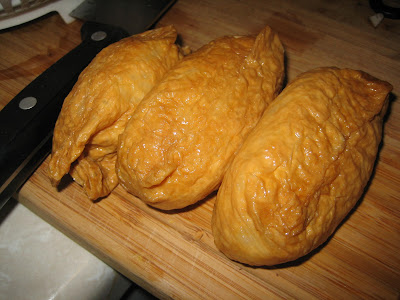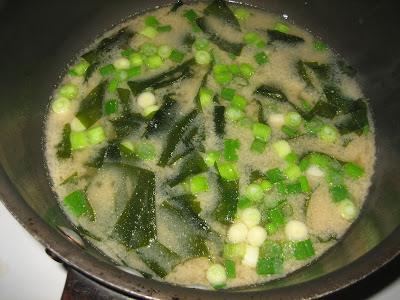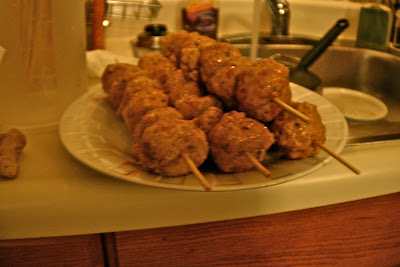"Your soul is straight and honest... but right now you've gone badly askew."
Book:
Rurouni Kenshin by Nobuhiro Watsuki
Recipes:
The Complete Book of Japanese Cooking by Emi Kazuko
Su Meshi (sort of)
(Sushi Rice)
An indeterminate amount of cooked sticky rice
8 tsp sugar
2 tsp sea salt
3 tbsp rice vingar
Mix all the ingredients together and hope that you end up with something that's not too vinegary.
I think we used about 2 cups of cooked rice. I'm not really sure, because kitchen helper Jessica was in charge of it while I ran out for groceries. As I'm looking back at the instructions, I can totally see why this recipe was a disaster. The actual recipe for the abura age refers you (indirectly) to the recipe for su-meshi, which refers you to the recipe for "Japanese" rice, which is wholly confusing. It says to use 15% more water than rice, but immediately after says that for one cup of rice you would use 1 cup of water. *shrug* I think Jessica navigated that beautifully, ignored the 1:1 misprint and figured the math for the 15%, because the rice cooked perfectly. Once you have this indeterminate amount of rice, you are supposed to add the other ingredients, but since it never says how much rice to use, (it gives you a tip for how much rice will make a certain amount of sushi rolls, but doesn't actually say that's how much rice the recipe calls for...) I think we didn't use enough, because our rice was way too vinegary.
This is actually the third time that I've run into measurement issues with this same cookbook and I'm only glad I bought it at The Strand and didn't have to pay full price.
Abura Age Inari
(Fried Thin Tofu Stuffed with Sushi Rice)
1 package of abura-age (ready to use)
Enough dashi stock to cover the abura age in the pan (maybe one cup)
2 tbsp sake
4 1/2 tbsp shoyu
A generous quantity of su-meshi made with 8 tsp sugar
Rinse the abura age and drain well. Lay them in a pan and pour in enough dashi stock to cover them.
Bring to a boil, reduce heat, cover and simmer for 20 minutes. Add the sugar in 3 batches during this time, shaking the pan to dissolve it (do not stir). Simmer for a further 15 minutes after all the sugar has been added. Add the sake and shake the pan again, then add the shoyu in three batches. Simmer until almost all the liquid has evaporated. Transfer to a wide sieve and leave to drain.
Shape the rice into a rough rectangle just smaller than the abura-age half and stuff inside. The cookbook says to "press the edges together to seal the bag" but no amount of pressing was going to keep those together. Jessica sort of delicately rolled her edges, I just sort of flopped mine together and flipped the whole over to hide its shame.
Here is my disclaimer. Given all the measurement nonsense that surrounded this, it wasn't too bad. At least I didn't think so. Jessica was gracious enough not to spit her first bite out, but could not be coaxed into eating even another nibble. She referred to them as "the beasts." I actually ate a whole one, and at a 2 more for lunch the next day. I suggested bringing some to Yan, but Jessica dissuaded me on the grounds that I like Yan, and want to keep her as a friend.
The rice had too much vinegar and not enough sweetness, the abura age called for 3 1/2 cups of broth but said to just cover it, which I didn't understand until after I'd realized that it was going to take 5 hours to simmer off all that liquid and I should have ignored the instructions, so I poured it out, probably pouring out all the sugar and sweetness that would have stayed in the abura-age in the process. It was frustrating, but unlike Jessica, I'm not afraid to try it again, but I will know next time to make it ahead of when you want to eat it. Look for this to be revisited soon. My plan is use internet research to double check recipe amounts on this book every time for now on. Onward to the good bits of the dinner.
Kakiage
(Tempura Shrimp and Corn Fritters)
For the filling:
1 lb uncooked baby shrimp, peeled and de-veined (or chopped up jumbo shrimp, if that's all Pathmark can offer you)
1 can corn
4 spring onions, chopped
Half a package of button mushrooms, chopped
For the tempura batter:
1 1/4 cups ice cold water
2 eggs, beaten
1 1/4 cups flour
1/4 tsp baking powder
For the dipping sauce:
1 2/3 cups of dashi stock
1/2 cup shoyu
1/2 cup mirin
1 tbsp chives, chopped
Oil for frying
In a saucepan, combine all the liquid ingredients for the dipping sauce and bring to a boil. Turn off the heat and sprinkle with chives.
Mix all the filling ingredients together and set aside.
Mix all the batter ingredients together and stir with chopsticks (it should be lumpy). Add the batter to the filling and stir to coat. Heat the oil over high heat, add small spoonfulls of the shrimp mixture cover, and cook until browned and crispy. Drain on paper towels while you cook the next batch. Serve hot with the warm dipping sauce.
These came out much better than the beasts. When the corn started to fry it scared us a bit with it's popping and spitting sounds, but it the end result was perfect. We didn't make the dipping sauce, thinking we didn't need it, but I was desperate for some extra saltiness, so I just threw some soy sauce and mirin together (it was too strong, but with just a little taste of it, it was enough). We also made the miso soup correctly, with real dashi stock and mushrooms.
About the book:
Cliffhanger! And! My student does not have Volume 2, which means if I want to find out how it ends, I will have to go and buy it for him.
Basically, in true serial writer fashion, the best bit was saved for right before the end of the volume. Our friend Himura meets another fighter, a man who is paid to fight others. But, he says, "I refuse to fight anyone weak. My recent fights have been boring and I'm getting tired of it." So, when some of the thugs from Act 1 show up again wanting revenge on Battosai, they tempt Sanosuke with the challenge of fighting a real master samurai. Of course, Himura doesn't want to fight because Sanosuke's Chi is only clouded, not truly evil.
Honor and weapons make an appearance in this one as well, as the thug brothers have brought a gun to finish off Battosai after he's been weakened by Sanosuke. This is a dishonorable thing to do, and Sanosuke himself takes the gun and breaks. He will fight with a more traditional weapon, the Zanbato. "Zanbato: a giant sword invented before the Sengoku or 'warring states. period, designed to take down a rider and his horse in one swing. It is the heaviest katana ever made. Because of its weight, it is said that no one has even been able to wield it to its full capacity" (this is real, not Manga fiction!).
And thus ends the issue. Rats. Not to fear though, there's an anime series which I've ordered from Netflix and should arrive soon. And my faithful student has delivered up yet another Manga for me to use as my book for future postings (look for a new one sometime tomorrow).






















 B
B











